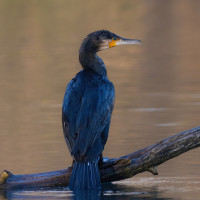Opis
Located in the town of Chevrier along the Rhône river, the Défilé de l'Ecluse has been a site known for over 60 years and renowned for autumn migration. From mid-July the migration flow starts with kania czarna and jerzyk and the movement can last until December with the myszołów. In between, many species can be seen either actively migrating or stationary. The topography of the area and the presence of the large wetland of Etournel are favorable to the stopping of a good number of species ranging from gulls to shrikes, including ducks, czajka or even sparrows by the hundreds. . Although the flypath formed by the Jura and Vuache massifs, concentrates a large part of the birds, raptors and bocian biały can pass far east.
_________________________
Français: Site de suivi de la migration Post-Nuptial du Défilé de l'Ecluse. Site de suivi de la migration post-nuptial des oiseaux, surtout rapace et grand voilier. 1er site de migration en nombre pour le kania ruda. Situé sur la commune de Chevrier le long du fleuve Rhône, le Défilé de l’Ecluse est un site connu depuis plus de 60 ans et réputé pour la migration postnuptiale. Les kania czarna et jerzyk sont les premiers à animer le site dès la mi-juillet et le mouvement peut durer jusqu’en décembre avec les myszołów ; entre les deux, de nombreuses espèces peuvent être contactées soit en migration active, soit en stationnement. En effet la topographie du secteur et la présence de la grande zone humide de l’Etournel sont favorables à la halte de bon nombre d’espèces allant des ardéidés aux pie-grièches en passant par les canards, les vanneaux où encore les passereaux par centaines. Bien que le Défilé en lui même, c'est-à-dire la cluse que forme les massifs du Jura et du Vuache, concentre une grande partie des oiseaux, il faut cependant rester attentif puisque la sphère d’observation est immense et il arrive fréquemment que rapaces et Cigognes blanches passe loin vers l'est.
Szczegóły
Dostęp
From Bellegarde-sur-Valserine take direction Collonges (Pays de Gex 01). After the Fort’Ecluse tunnel, turn right towards Vulbens - Valleiry on the N206. 1500 m. after Pont Carnot, take the first right before the SNCF bridge; pass the picnic area then walk along the railway line for 300 m.
From Saint-Julien-en-Genevois take direction Viry - Valleiry then Vulbens on the N206. After Vulbens continue for about 1500 m. and turn left towards Chevrier; climb 400 m. then take the first right, continue for 1500m. between house and orchard to the railway line, after it turn right, walk along the railway line for 400 m.
_________________________
Français: Depuis Bellegarde-sur-Valserine prendre direction Collonges (Pays de Gex 01). Après le tunnel du Fort l’Ecluse prendre à droite direction Vulbens – Valleiry sur la N206. 1500 m. après le Pont Carnot, prendre la première à droite avant le pont SNCF ; passer l’aire de pique-nique puis longer la voie ferrée sur 300 m. c’est ici !
Depuis Saint-Julien-en-Genevois prendre direction Viry – Valleiry puis Vulbens sur la N206. Après Vulbens continuer sur environ 1500 m. et prendre à gauche direction Chevrier ; monter sur 400 m. puis prendre la première à droite, continuer sur 1500m. entre habitation et verger jusqu'à la voie ferrée, après celle-ci prendre à droite, longer la voie ferrée sur 400 m. c’est ici !






